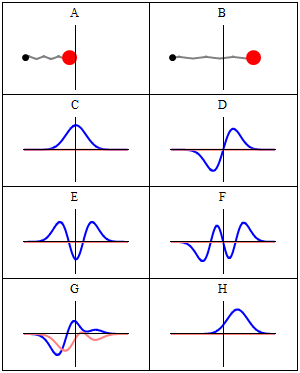Schrödinger equation
Schrödinger equation is a fundamental equation in quantum mechanics that describes how the quantum state of a physical system changes over time. It was formulated in 1925 by the Austrian physicist Erwin Schrödinger, and it plays a pivotal role in the theory of quantum mechanics, similar to Newton's laws of motion in classical mechanics.
Overview
The Schrödinger equation provides a way to predict the future behavior of particles at the quantum level, such as electrons, atoms, and molecules. It is a wave equation in terms of the wave function, which is a mathematical description of the quantum state of a system. The square of the absolute value of the wave function represents the probability density of finding a particle in a given place at a given time.
Types of Schrödinger Equations
There are two main forms of the Schrödinger equation: the time-dependent Schrödinger equation and the time-independent Schrödinger equation.
Time-Dependent Schrödinger Equation
The time-dependent Schrödinger equation describes how the quantum state of a system evolves over time. It is given by: \[ i\hbar\frac{\partial}{\partial t}\Psi(\mathbf{r},t) = \hat{H}\Psi(\mathbf{r},t) \] where \(i\) is the imaginary unit, \(\hbar\) is the reduced Planck's constant, \(\Psi(\mathbf{r},t)\) is the wave function of the system, \(t\) is time, \(\mathbf{r}\) represents the position vector, and \(\hat{H}\) is the Hamiltonian operator, which represents the total energy of the system.
Time-Independent Schrödinger Equation
The time-independent Schrödinger equation is used for systems with energies that do not change over time. It is derived from the time-dependent equation for stationary states and is given by: \[ \hat{H}\psi(\mathbf{r}) = E\psi(\mathbf{r}) \] where \(\psi(\mathbf{r})\) is the time-independent wave function, and \(E\) represents the energy eigenvalues of the system.
Applications
The Schrödinger equation is used in various areas of physics and chemistry to solve problems involving the behavior of particles at the quantum level. It is essential for understanding phenomena such as quantum tunneling, atomic orbitals, and the behavior of electrons in semiconductors. It also forms the basis for advanced theories and technologies, including quantum computing and quantum cryptography.
Historical Context
The development of the Schrödinger equation marked a significant advancement in the field of quantum mechanics. Schrödinger was motivated by the earlier work of Louis de Broglie and Albert Einstein's photoelectric effect, leading him to propose the wave nature of particles. His work, along with that of Werner Heisenberg's matrix mechanics, formed the foundation of modern quantum mechanics.
Conclusion
The Schrödinger equation is a cornerstone of quantum mechanics, providing a comprehensive framework for understanding the quantum world. Its formulation not only advanced the field of physics but also opened new avenues for research and technology development in the 20th and 21st centuries.
Transform your life with W8MD's budget GLP-1 injections from $125.
W8MD offers a medical weight loss program to lose weight in Philadelphia. Our physician-supervised medical weight loss provides:
- Most insurances accepted or discounted self-pay rates. We will obtain insurance prior authorizations if needed.
- Generic GLP1 weight loss injections from $125 for the starting dose.
- Also offer prescription weight loss medications including Phentermine, Qsymia, Diethylpropion, Contrave etc.
NYC weight loss doctor appointments
Start your NYC weight loss journey today at our NYC medical weight loss and Philadelphia medical weight loss clinics.
- Call 718-946-5500 to lose weight in NYC or for medical weight loss in Philadelphia 215-676-2334.
- Tags:NYC medical weight loss, Philadelphia lose weight Zepbound NYC, Budget GLP1 weight loss injections, Wegovy Philadelphia, Wegovy NYC, Philadelphia medical weight loss, Brookly weight loss and Wegovy NYC
|
WikiMD's Wellness Encyclopedia |
| Let Food Be Thy Medicine Medicine Thy Food - Hippocrates |
Medical Disclaimer: WikiMD is not a substitute for professional medical advice. The information on WikiMD is provided as an information resource only, may be incorrect, outdated or misleading, and is not to be used or relied on for any diagnostic or treatment purposes. Please consult your health care provider before making any healthcare decisions or for guidance about a specific medical condition. WikiMD expressly disclaims responsibility, and shall have no liability, for any damages, loss, injury, or liability whatsoever suffered as a result of your reliance on the information contained in this site. By visiting this site you agree to the foregoing terms and conditions, which may from time to time be changed or supplemented by WikiMD. If you do not agree to the foregoing terms and conditions, you should not enter or use this site. See full disclaimer.
Credits:Most images are courtesy of Wikimedia commons, and templates, categories Wikipedia, licensed under CC BY SA or similar.
Contributors: Prab R. Tumpati, MD






